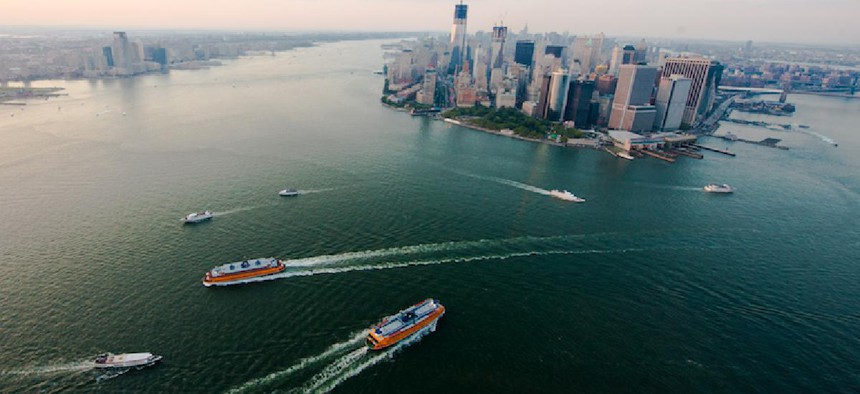When New York’s Citywide Ferry Service begins next year, it will offer fast, scenic commutes over open water at the price of a subway ticket – one more terrific example of New Yorkers rediscovering our maritime roots in new ways. The third largest commercial port in the country, New York Harbor also hosts scores of sailors, cruise ships large and small, excursion vessels, paddlers, rowers, tug and barge traffic and educational and historic boats. And with the launch of the ferry service, the city’s fleet of ferries, already the nation's largest, is about to expand.
When a ferry plowed into a pod of kayakers on the Hudson River two months ago, however, repercussions rippled through the city. What if expanded ferry service translates into more accidents on the water?
Actually, considering the bustling commercial, recreational and transportation activity throughout the harbor, it’s remarkable that the waterways of New York and New Jersey have been virtually free of major incidents. The excellent safety record of the waterways stands in sharp contrast to congestion and fatal crashes that still plague our city’s streets. Even with the progress made under Mayor Bill de Blasio’s Vision Zero, we have witnessed the tragic deaths of 98 people in traffic incidents and crashes through August of 2016, up 6 percent from the same period the previous year. Our streets are a conflict zone, with pedestrians and cyclists and motorists competing for precious space.
In contrast, a long-standing culture of safety reigns on the open waters, supported by collaboration and communication. For instance, most paddling groups use marine band radios to communicate with captains of commercial vessels and other harbor traffic. There are exceptions – I’m looking at you, jet skis – but the vast majority of harbor users are vigilant about safety, respect the “rules of the road,” and have a track record to prove it.
The strong safety record on our waterways is no accident. The U.S. Coast Guard Sector New York, the largest command in the country, plays a central role ensuring safe navigation. The NYPD Harbor unit regularly rescues people from our waterways, including those 10 kayakers in August. When accidents occur, the Coast Guard conducts a thorough investigation to prevent similar incidents in the future. Many street safety advocates rightly note that such diligence is sorely lacking for crashes involving motorists, pedestrians and bicyclists.
One of the secrets to the Coast Guard’s success is the Harbor Safety, Navigation and Operations Committee, or Harbor Ops for short. This unpaid task force represents a cross-section of maritime users: pilots who guide ocean-going cargo ships to port, tug and barge operators, commuter ferry captains and recreational paddlers and rowers. They provide valuable advice to the Coast Guard about events, activities and procedures that affect harbor safety. They also discuss close calls and how to prevent these from escalating into dangerous situations.
Earlier this year, a subcommittee of Harbor Ops organized the Captains and Paddlers Shared Harbor Tour, where more than 100 mariners shared insights about how best to collaborate and continue safe practices. Just last week, representatives from the New York City Economic Development Corporation and Hornblower (CFS operator) gave a presentation to the Harbor Ops subcommittee members, reassuring them that state-of-the-art safety elements are being built into the new, high-tech, CFS passenger vessels. Horns will be multi-directional instead of just facing forward and multiple cameras will be installed to aid in keeping lookout. The CFS team is also embracing feedback about fast ferries passing slower boat traffic, incorporating the shared waters concept into their operational procedures.
Other common sense reforms are still needed. For example, we need better wake awareness from irresponsible boat traffic, and enforcement when no-wake rules are flouted. Such behavior not only creates dangerous conditions for other harbor users, but also exacerbates coastal erosion. Also, many states also require education or licensing for recreational boaters. New York should follow suit.
Our harbor is a magnificent resource, and the reason our city exists as a thriving coastal metropolis. Its increased use for recreation, education and commerce is something to celebrate. The launch of Citywide Ferry Service next year will be a huge quality of life improvement for many New Yorkers, not a cause for concern. As a mugging should not result in park closures, the rare boating accident should not diminish the increasing use of our harbor. Rather, each incident should encourage more vigilance and communication, allowing us all to employ and enjoy the waters that surround us.
Roland Lewis is president and CEO of the Waterfront Alliance.
NEXT STORY: The missed opportunities of Sandy recovery


